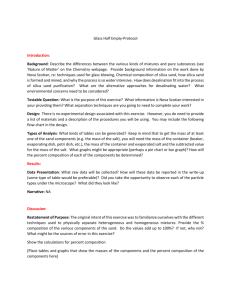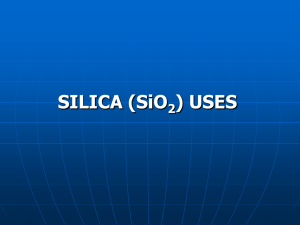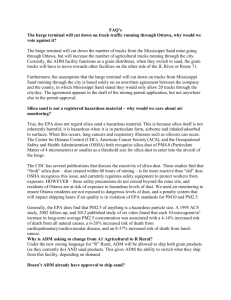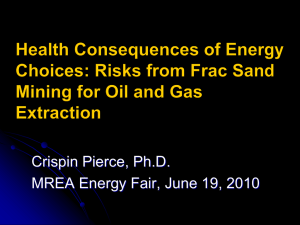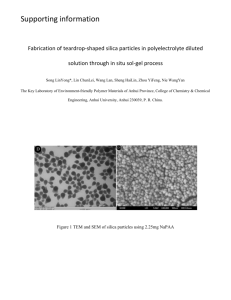DEFINITIONS_EQB
advertisement
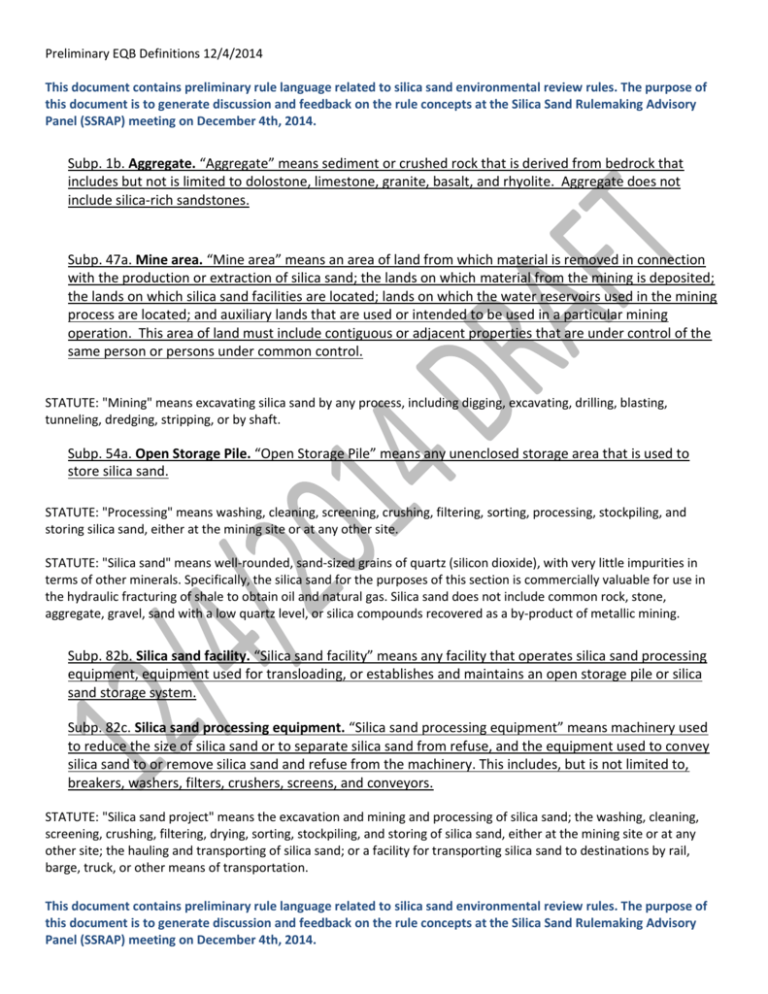
Preliminary EQB Definitions 12/4/2014 This document contains preliminary rule language related to silica sand environmental review rules. The purpose of this document is to generate discussion and feedback on the rule concepts at the Silica Sand Rulemaking Advisory Panel (SSRAP) meeting on December 4th, 2014. Subp. 1b. Aggregate. “Aggregate” means sediment or crushed rock that is derived from bedrock that includes but not is limited to dolostone, limestone, granite, basalt, and rhyolite. Aggregate does not include silica-rich sandstones. Subp. 47a. Mine area. “Mine area” means an area of land from which material is removed in connection with the production or extraction of silica sand; the lands on which material from the mining is deposited; the lands on which silica sand facilities are located; lands on which the water reservoirs used in the mining process are located; and auxiliary lands that are used or intended to be used in a particular mining operation. This area of land must include contiguous or adjacent properties that are under control of the same person or persons under common control. STATUTE: "Mining" means excavating silica sand by any process, including digging, excavating, drilling, blasting, tunneling, dredging, stripping, or by shaft. Subp. 54a. Open Storage Pile. “Open Storage Pile” means any unenclosed storage area that is used to store silica sand. STATUTE: "Processing" means washing, cleaning, screening, crushing, filtering, sorting, processing, stockpiling, and storing silica sand, either at the mining site or at any other site. STATUTE: "Silica sand" means well-rounded, sand-sized grains of quartz (silicon dioxide), with very little impurities in terms of other minerals. Specifically, the silica sand for the purposes of this section is commercially valuable for use in the hydraulic fracturing of shale to obtain oil and natural gas. Silica sand does not include common rock, stone, aggregate, gravel, sand with a low quartz level, or silica compounds recovered as a by-product of metallic mining. Subp. 82b. Silica sand facility. “Silica sand facility” means any facility that operates silica sand processing equipment, equipment used for transloading, or establishes and maintains an open storage pile or silica sand storage system. Subp. 82c. Silica sand processing equipment. “Silica sand processing equipment” means machinery used to reduce the size of silica sand or to separate silica sand from refuse, and the equipment used to convey silica sand to or remove silica sand and refuse from the machinery. This includes, but is not limited to, breakers, washers, filters, crushers, screens, and conveyors. STATUTE: "Silica sand project" means the excavation and mining and processing of silica sand; the washing, cleaning, screening, crushing, filtering, drying, sorting, stockpiling, and storing of silica sand, either at the mining site or at any other site; the hauling and transporting of silica sand; or a facility for transporting silica sand to destinations by rail, barge, truck, or other means of transportation. This document contains preliminary rule language related to silica sand environmental review rules. The purpose of this document is to generate discussion and feedback on the rule concepts at the Silica Sand Rulemaking Advisory Panel (SSRAP) meeting on December 4th, 2014. Preliminary EQB Definitions 12/4/2014 Subp. 82e. Silica sand rejects. “Silica sand rejects” means Earthen material, such as surface overburden or sediment, that remains after processing and is not part of the finished product. Sub. 82f. Silica sand storage system. “Silica sand storage system” means any facility used to store silica sand except for open storage piles. Subpart 83a. Silica-rich sandstones. “Silica-rich standstones” means earthen material consisting of quartzose sedimentary rock of mostly sand-sized particles. Quartzose is a physical characteristic of a sedimentary rock formation where greater than 90% of the constituent rock particles consist of pure quartz. Silica-rich sandstones Examples of silica-rich sandstones include the formally recognized and described quartzose sandstones defined by the Minnesota Geologic Survey Report of Investications 65: Paleozoic Stratigraphic Nomenclature for Minnesota, 2008. STATUTE: "Temporary storage" means the storage of stockpiles of silica sand that have been transported and await further transport. Subp. 89a. Transloading. “Transloading” means the process of transferring silica sand from one vehicle to another vehicle. Silica sand may be stored or handled before exchange to a different vehicle. STATUTE: Transporting" means hauling and transporting silica sand, by any carrier: (1) from the mining site to a processing or transfer site; or (2) from a processing or storage site to a rail, barge, or transfer site for transporting to destinations. Subp. 89d. Underground mine. “"Underground mine" means below surface mining. Examples are excavation of adits, shafts, drifts, and stopes. Access is often via horizontal drifts or gradual declines into the earth to reach underground in place, silica sand deposits. Mining is typically by room and pillar or open stope mining methods. This document contains preliminary rule language related to silica sand environmental review rules. The purpose of this document is to generate discussion and feedback on the rule concepts at the Silica Sand Rulemaking Advisory Panel (SSRAP) meeting on December 4th, 2014.
![LAB 4 FB Safety [BH]](http://s3.studylib.net/store/data/007109339_1-10edf2f99cf9e3f5eb5770ce96c065cf-300x300.png)
